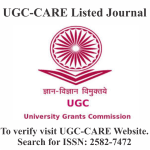RESEARCH VISIBILITY OF FACULTY MEMBERS OF NAVRACHANA UNIVERSITY ON RESEARCH GATE
DOI:
https://doi.org/10.29121/shodhkosh.v5.i5.2024.4926Keywords:
Navrachana University, Research Gate, Research Visibility, Academic Social Networking SiteAbstract [English]
The Study highlights the function of academic social networking sites in promoting research dissemination and collaboration by looking at the research visibility of Navrachana university faculty members on ResearchGate (RG). By analysing the profiles of 49 faculty members of Navrachana University across five disciplines such as Science, engineering and technology, Liberal Studies & Education, Business and Law, and Environmental Design and Architecture. The evaluation results shows that Science has highest articles 232 and the RG Score 2173.4, followed by Engineering & Technology. Liberal Studies and education prove notably strong engagement high reads and recommendations, led by Faculty Dr.Rishi Raj Balwaria. However, there is limited involvement and exposure in the Business and Law, Environmental Design and Architecture. The study Emphasizes how ResearchGate (RG) may create a global academic community by overcoming geographical and institutional boundaries.
References
Ahmad, Z. (2018). Profiles of the AMU and JNU researchers on ResearchGate: An altmetric analysis. Kelpro Bulletin, 23(1), 101-112.
Desai, M., Mehta, R. G., & Rana, D. P. (2022). Anatomising the impact of ResearchGate followers and followings on influence identification. Journal of Information Science. Advance online publication. https://doi.org/10.1177/01655515221100716 DOI: https://doi.org/10.1177/01655515221100716
Míguez-González, M. I., Puentes-Rivera, I., & Dafonte-Gómez, A. (2016). Academic social networks and communication researchers from universities in the North of Portugal: An analysis of Academia.edu and ResearchGate. In F. Freire, X. Rúas Araújo, V. Martínez Fernández, & X. García (Eds.), Media and metamedia management (Vol. 503, pp. 405-411). Springer. https://doi.org/10.1007/978-3-319-46068-0_53 DOI: https://doi.org/10.1007/978-3-319-46068-0_53
Mondal, D., & Hadagali, G. S. (2021). Perspectives and use of ResearchGate by the research scholars of the University of Burdwan, Burdwan West Bengal, India: A study. Journal of Indian Library Association, 57(1), 47-59.
Mondal, D., & Kar, D. C. (2021). Usage of ResearchGate by the research scholars: A study of the University of Calcutta. Library Philosophy and Practice (e-journal), 5158. Retrieved from https://digitalcommons.unl.edu/libphilprac/5158
Raffaghelli, J. E., & Manca, S. (2023). Exploring the social activity of open research data on ResearchGate: Implications for the data literacy of researchers. Online Information Review, 47(1), 197–217. https://doi.org/10.1108/OIR-05-2021-0255 DOI: https://doi.org/10.1108/OIR-05-2021-0255
Shrivastava, R., & Mahajan, P. (2015). Relationship amongst ResearchGate altmetric indicators and Scopus bibliometric indicators: The case of Panjab University Chandigarh (India). New Library World, 116(9/10), 564–577. https://doi.org/10.1108/NLW-03-2015-0026 DOI: https://doi.org/10.1108/NLW-03-2015-0017
Shrivastava, R., & Mahajan, P. (2017). An altmetric analysis of ResearchGate profiles of physics researchers: A study of University of Delhi (India). Performance Measurement and Metrics, 18(1), 2–12. https://doi.org/10.1108/PMM-07-2016-0033 DOI: https://doi.org/10.1108/PMM-07-2016-0033
Subramani, R. (2015). The academic usage of social networking sites by the university students of Tamil Nadu. Online Journal of Communication and Media Technologies, 5(3), 162–175. https://doi.org/10.29333/ojcmt/2522 DOI: https://doi.org/10.29333/ojcmt/2522
Sulakshana, H. V., Sampath Kumar, B. T., & Basavaraja, M. T. (2021). Use of ResearchGate as a digital repository by the faculty members: An altmetric analysis. Journal of Indian Library Association, 57(1), 47-59.
Downloads
Published
How to Cite
Issue
Section
License
Copyright (c) 2024 Rucha Pandya, Meghna Vyas

This work is licensed under a Creative Commons Attribution 4.0 International License.
With the licence CC-BY, authors retain the copyright, allowing anyone to download, reuse, re-print, modify, distribute, and/or copy their contribution. The work must be properly attributed to its author.
It is not necessary to ask for further permission from the author or journal board.
This journal provides immediate open access to its content on the principle that making research freely available to the public supports a greater global exchange of knowledge.




















